U.S. Department of Transportation
Federal Highway Administration
1200 New Jersey Avenue, SE
Washington, DC 20590
202-366-4000
| < Previous | Table of Content | Next > |
Traffic engineers use a wide variety of road signs and pavement markings. Some are used to alert motorists to pedestrian activity and to direct pedestrians to defined crossings. Problems are created, however, when pedestrians assume that signs and paint will protect them from cars. Drivers, on the other hand, often ignore pedestrian signs and markings because they seldom see many pedestrians. As a result, signs and paint may lull pedestrians into a false sense of security. This lesson provides an overall philosophy for the use of signs and pavement markings, as well as details on how these traffic control measures should be employed. Crosswalk markings at intersections are covered in more detail in Lesson 15.
Signing is governed by the Manual on Uniform Traffic Control Devices (MUTCD), which provides specifications on the design and placement of traffic control signs installed within public rightsof- way. The MUTCD encourages a conservative use of signs (Sections 2A-1, 2A-6, 2B-1, and 2C-1). Signs should only be installed when they fulfill a need based on an engineering study or engineering judgment. In general, signs are often ineffective in modifying driver behavior, and overuse of signs breeds disrespect. Used judiciously and located with consistency, signs and markings can be effective. Jurisdictions should develop clear guidelines for use and should avoid overreliance on signs and paint to control motorist behavior. This may mean altering and/or relocating existing signs and markings. It may be best to eliminate markings and signs that have proven to be ineffective or deleterious to pedestrian safety. There is ongoing debate and studies in progress to determine whether markings (especially written messages) improve pedestrian safety, whether crosswalks are useful at mid-block locations, and whether signs contribute to visual overload for motorists and breed disrespect for messages.
The MUTCD outlines guidelines governing signs and pavement markings. At the same time, it does not prohibit creative regulatory design. The MUTCD does not define criteria for crosswalk location or striping options. Much is left to engineering judgment. As a result, there is leeway in adapting guidelines to specific signing and marking policy needs.
Seattle is developing a new sign aimed at educating and reminding motorists of the 1990 crosswalk legislation supported by citizens that requires motorists to stop for pedestrians in a crosswalk. The sign will be installed at locations where crosswalk or pedestrian signs are not appropriate. It is designed to be relocated after 4 to 6 weeks to another location. Coordination with the Seattle Police Department will ensure enforcement. Initially, Seattle will place four 760- millimeter x 900-millimeter (30-inch x 36-inch) signs in different locations around the city.
Colors for signs and markings should conform to the color schedule recommended by the MUTCD to promote uniformity and understanding from jurisdiction to jurisdiction. For the background color of signs, use:
For pavement markings, use:
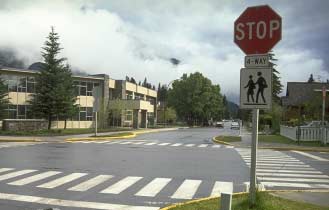
Stop for me it's the law
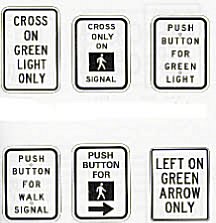 These
signs are used to inform motorists or pedestrians of a legal requirement and
should only be used when the legal requirement is not otherwise apparent.
They are generally rectangular in shape, usually consisting of a black legend
on a white background, and shall be reflectorized or illuminated. Many motorist
signs, including stop signs, yield signs, turn restrictions, and speed limits,
have a direct or indirect impact on pedestrians.
These
signs are used to inform motorists or pedestrians of a legal requirement and
should only be used when the legal requirement is not otherwise apparent.
They are generally rectangular in shape, usually consisting of a black legend
on a white background, and shall be reflectorized or illuminated. Many motorist
signs, including stop signs, yield signs, turn restrictions, and speed limits,
have a direct or indirect impact on pedestrians.
The NO TURN ON RED (R10-11a) sign may be used in some instances to facilitate pedestrian movements. The Manual on Uniform Traffic Control Devices (MUTCD) lists six conditions when "no turn on red" may be considered, three of which are directly related to pedestrians or signal timing for pedestrians. Considerable controversy has arisen regarding pedestrian safety implications and right turn on red operations, ranging from a study by Zador, which indicated a significant increase in pedestrian accidents with right-turn-on-red, to studies by AASHTO and McGee, which concluded that right turn on red does not create a pedestrian safety problem.
The use of NO TURN ON RED signs at an intersection should be evaluated on a case-by-case basis. Less restrictive alternatives should be considered in lieu of NO TURN ON RED. Also, supplementary signs, such as WHEN PEDESTRIANS ARE PRESENT or WHEN CHILDREN ARE PRESENT may be placed below the NO TURN ON RED sign.
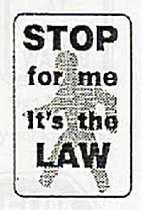
There are occasions when no-turn-on-red restrictions are beneficial, and specific recommendations relating to pedestrians include:
There are a number of regulatory signs directed at pedestrians, which include:
Other signs may be used for pedestrians at traffic signals to define the meaning of the WALK, DON'T WALK, and flashing DON'T WALK signal indications. The decision to use these signs (or alternatively, stickers mounted directly on the signal pole) is strictly engineering judgment and is primarily for educational purposes. As such, their use may be more helpful near schools and areas with concentrations of elderly pedestrians-two high-risk areas. This information may also be effectively converted into brochures for distribution and ongoing educational purposes.
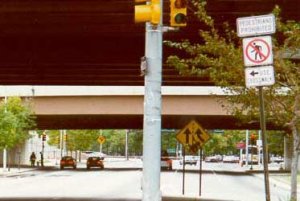
Pedestrians are restricted from continuing straight and are encouraged
to cross to the left to avoid a vehicular merge lane.
Warning signs are used to inform unfamiliar motorists/ pedestrians of unusual or unexpected conditions. Warning signs predominantly fall under the permissive category ("may" condition), and when used, should be placed to provide adequate response times. Warning signs are generally diamond-shaped with black letters or drawings on a yellow background and shall be reflectorized or illuminated. Overuse of warning signs breeds disrespect and should be avoided.
The warning sign predominantly used to warn motorists of possible pedestrian conflicts is the Advance Pedestrian Crossing sign (W11-2). This sign should be installed in advance of mid-block crosswalks or other locations where pedestrians may not be expected to cross. This significantly minimizes their use at most urban intersections since pedestrian crossings are an expected occurrence. This sign may also be selectively used in advance of high-volume pedestrian crossing locations to add emphasis to the crosswalk. The advance pedestrian crossing sign provides more advance warning to motorists than crosswalk markings, and on some occasions, may be used when crosswalk markings do not exist. Where there are multiple crossing locations that cannot be concentrated to a single location, a supplemental distance plate may be used (NEXT XXX FEET). The advance pedestrian crossing signs should not be mounted with another warning sign (except for a supplemental distance sign or an advisory speed plate) or regulatory sign (except for NO PARKING signs) to avoid information overload and to allow for an improved driver response. Care should be taken in sign placement in relation to other signs to avoid sign clutter and to allow adequate motorist response. The MUTCD specifies a 30-inch x 30-inch sign size. However, it may be helpful to use a larger (36-inch x 36-inch) sign on higher speed or wider arterial streets.
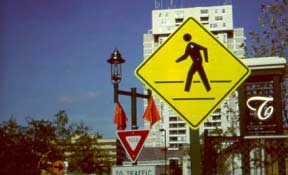 This pedestrian warning sign is fluorescent yellow green (FYG) allowing it to be more visible. |
The Pedestrian Crossing sign (W11A-2) is similar to the Advance Pedestrian Crossing sign, but has the crosswalk lines shown on it. This sign is intended to be used at the crosswalk, which is the only warning sign not used in advance of the condition being warned (except for large arrow signs and object markers). Because of its placement and the motorist's inability to distinguish and comprehend the subtle difference between the two signs (W11-2 versus W11A-2), its usefulness is limited. When used, it should be preceded by the advance warning sign and should be located immediately adjacent to the crossing point. To help alleviate motorist confusion, a black-and-yellow diagonally downward pointing arrow sign may be used to supplement the pedestrian crossing sign (W11A-2).
The Playground sign (W15-1) may be used in advance of a designated children's play area to warn motorists of a potentially high concentration of young children. This sign should generally not be needed on local or residential streets where children are expected. Furthermore, play areas should not be located adjacent to high-speed major or arterial streets, or if so, should be fenced off to prevent children from darting into the street.
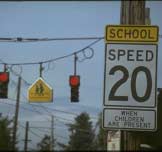 Flashing lights, school crossing signs, and a 20-mph speed limit should give motorists plenty of advance warning of the crossing area up ahead. |
According to the Traffic Control Devices Handbook, CAUTION-CHILDREN AT PLAY or SLOW CHILDREN signs should not be used since they may encourage children to play in the street and may encourage parents to be less vigilant. Such signs also provide no guidance to motorists in terms of a safe speed, and the sign has no legal basis for determining what a motorist should do. Furthermore, motorists should expect children to be "at play" in all residential areas, and the lack of signing on some streets may indicate otherwise. The signs are unenforceable and act as another roadside obstacle to pedestrians and errant motorists. Use of these non-standard signs may also imply that the involved jurisdiction approves of streets as playgrounds, which may result in the jurisdiction being vulnerable to tort liability.
School Warning signs include the advance school crossing signs (S1-1), the school crossing sign (S2-1), SCHOOL BUS STOP AHEAD (S3-1) sign, and others. School-related traffic control devices are discussed in detail in Part VII (Traffic Controls for School Areas) of the MUTCD. A reduced speed limit sign with flashing lights can be installed ahead of the actual crossing. The lights are set to flash during school hours, alerting drivers that a lower speed limit is in effect when the flashers are operating. Another sign and light combination is SCHOOL SPEED LIMIT XX, where the speed limit is illuminated during school hours.
The MUTCD allows for the development of other specialty warning signs based on engineering judgment for unique conditions. These signs can be designed to alert unfamiliar motorists or pedestrians of unexpected conditions and should follow the general criteria for the design of warning signs. Their use should be minimized to retain effectiveness and should be based on engineering judgment.
Directional signs for pedestrians are intended to assist people who are new to the area or to assist residents who may not know the most direct route to a destination by foot. Use distances meaningful to pedestrians, such as the number of blocks or average walking time.
The MUTCD allows for the use of pavement word and symbol markings such as SCHOOL XING or PED XING, as motorist warning devices (Section 3B-20). These may be helpful on high-volume or highspeed streets with unusual geometrics (such as vertical or horizontal curves) in advance of a pedestrian crossing area. Markings should be white and placed to provide an adequate motorist response. Their use should be kept to a minimum to retain effectiveness. Consideration should be given to snow conditions that may obliterate the markings during portions of the year in some regions of the country and the agency's ability to maintain these pavement markings. If used, the word or symbol markings should generally be used in each approach lane (except for the SCHOOL message).
Some agencies have also attempted to communicate with pedestrians by using pavement word markings such as LOOK BOTH WAYS or other symbols to encourage pedestrians to look for vehicles and to enter the road cautiously.
All pavement word and symbol markings require periodic maintenance and replacement after resurfacing. If used, it is advisable to maintain an inventory of stencils for periodic checking and refurbishment.
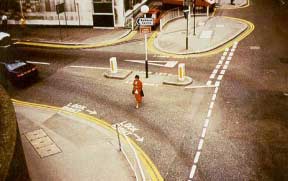 "Look Right" or "Look Left" are painted on the street next to the curb in the United Kingdom to remind pedestrians which direction in which to look for oncoming traffic before stepping into the street. |
The need to develop and detail pedestrian signs and pavement markings in a manner in which these provisions can be constructed within the normal field of highway construction is an extremely important issue. Signs and pavement markings for a proposed roadway project are specified through a detailed system of standard drawings, specifications, and bid item numbers. An example plan view drawing demonstrating this method for highway-related signs and pavement markings using Caltrans (California Department of Transportation) specifications is provided for reference in Figure 14-1.
Engineers use the standards to ensure uniform construction and contractors use the standards to develop construction cost estimates for their bids. The use of these procedures in developing designs is a critical link in the continuum of planning, designing, and constructing transportation facilities. Construction of pedestrian and bicycle facilities should make full use of this well-established system. Most State DOT's have a variety of specifications that pertain to pedestrian and bicycle facilities. Specific standard drawings pertaining to bicycle and pedestrian facility construction as taken from the Caltrans Standard Plans document are summarized below.
Develop a plan to install pedestrian signs and pavement markings that uses nomenclature and reference standards from your State DOT. Estimate the quantity of each construction item needed and develop an engineer's construction cost estimate. You will need to utilize the following resources:
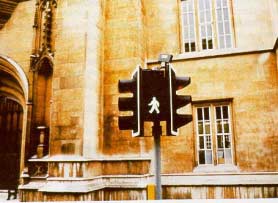
Text and graphics for this section were derived from the following sources:
Federal Highway Administration, Implementing Pedestrian Improvements at the Local Level, 1998.
ITE, Design and Safety of Pedestrian Facilities-A Recommended Practice of ITE, Washington, DC, 1998.
Manual on Uniform Traffic Control Devices, USDOT, 1988.
For more information on this topic, refer to:
Florida Department of Transportation, Florida Pedestrian Facility Planning and Design Guidelines, 1996.
Oregon Department of Transportation, Oregon Bicycle and Pedestrian Plan, 1995.
Pennsylvania Department of Transportation, Pennsylvania Pedestrian Planning and Design Guidelines and Pennsylvania Community Design Systems, 1996.
Figure 14-1: Example Signing and Marking Plan S.R. 8, Fletcher Parkway Construction Plans Le Mesa, California
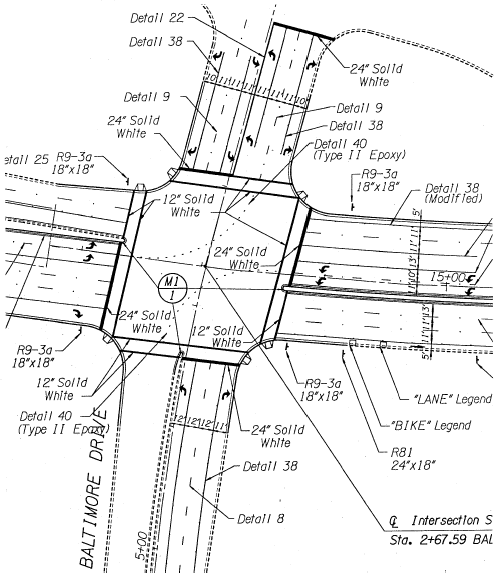
| < Previous | Table of Content | Next > |
